Experimental and Numerical Investigation of Ballistic Resistance of Polyurea-Coated Aluminum Plates under Projectile Impacts
Abstract
1. Introduction
2. Experimental and Simulation Setup
2.1. Experimental Setup
2.2. Materials
2.3. Simulation Model
3. Results and Discussion
3.1. Effect of Polyurea Coating on Energy Absorption
3.2. Dynamic Failure of Coating Plate
3.3. Numerical Results
4. Failure Mechanisms
4.1. Damage Appearance of Composite Layered Plate
4.2. Effect of Polyurea Coating on Energy Absorption
5. Conclusions
Author Contributions
Funding
Acknowledgments
Conflicts of Interest
References
- Leblanc, J.; Gardner, N.; Shukla, A. Effect of polyurea coatings on the response of curved E-Glass/Vinyl ester composite panels to underwater explosive loading. Compos. Part B—Eng. 2013, 44, 565–574. [Google Scholar] [CrossRef]
- Yue, Z.Y.; Zhou, J.N.; Kong, X.L.; Xu, Y.; Chen, Y.S.; Wang, B.; Huang, Y.M.; Wang, P. Anti-blast performance of polyurea-coated concrete arch structures. Polymers 2023, 15, 1263. [Google Scholar] [CrossRef]
- Wang, J.G.; Ren, H.Q.; Wu, X.Y.; Cai, C.L. Blast response of polymer-retrofitted masonry unit walls. Compos. Part. A—Appl. S. 2017, 128, 174–181. [Google Scholar] [CrossRef]
- Toader, G.; Moldovan, A.E.; Diacon, A.; Dirloman, F.M.; Rusen, E.; Podaru, A.; Rotariu, T.; Ginghina, R.E.; Hoza, O.E. Effect of Aromatic Chain Extenders on Polyurea and Polyurethane Coatings Designed for Defense Applications. Polymers 2023, 15, 756. [Google Scholar] [CrossRef] [PubMed]
- Gang, W.A.; Xin, W.A.; Chong, J.A.; Liu, Q.; Gao, Z. Experimental and numerical simulation study on polyurea-coated fuel tank subjected to combined action of blast shock waves and fragments. Thin Walled Struct. 2021, 169, 108436. [Google Scholar]
- Petre, R.; Zecheru, T.; Ginghina, R. Dynamic tests on polyurea-based hybrid composites for ballistic protection. Mater. Plast. 2021, 58, 41–47. [Google Scholar] [CrossRef]
- Cui, J.; Shi, Y.C.; Zhang, X.H.; Huang, W.B.; Ma, M.L. Experimental study on the tension and puncture behavior of spray polyurea at high strain rates. Polym. Test. 2021, 93, 106863. [Google Scholar] [CrossRef]
- Yi, J.; Boyce, M.C.; Lee, G.F.; Balizer, E. Large deformation rate-dependent stress-strain behavior of polyurea and polyurethanes. Polymers 2006, 47, 319–329. [Google Scholar] [CrossRef]
- Mohotti, D.; Ali, M.; Ngo, T.; Lu, J.H.; Mendis, P. Strain rate dependent constitutive model for predicting the material behaviour of polyurea under high strain rate tensile loading. Mater. Design. 2014, 53, 830–837. [Google Scholar] [CrossRef]
- Liu, Z.B.; Chen, H.T. Deformation mechanism and failure-tolerant characteristics of polymer-coated sheet metal laminates subjected to different loading conditions. J. Mater. Res. Technol. 2020, 9, 3907–3923. [Google Scholar] [CrossRef]
- Huang, X.L.; Zhang, W.; Deng, Y.F.; Jiang, X.W. Experimental investigation on the ballistic resistance of polymer-aluminum laminated plates. Int. J. Impact Eng. 2018, 113, 212–221. [Google Scholar] [CrossRef]
- Amini, M.R. Effect of Polyurea on Dynamic Response and Fracture Resistance of Steel Plates under Impulsive Loads. Ph.D. Thesis, University of California, San Diego, CA, USA, 2007. [Google Scholar]
- Mohagheghian, I.; Mcshane, G.J.; Stronge, W.J. Quasi-static and impact perforation of polymer-metal bi-layer plates by a blunt indenter. Thin Walled Struct. 2017, 117, 35–48. [Google Scholar] [CrossRef]
- Wu, G.; Wang, X.; Ji, C.; Liu, Y. Anti-blast properties of 6063-T5 aluminum alloy circular tubes coated with polyurea elastomer: Experiments and numerical simulations. Thin Walled Struct. 2021, 164, 107842. [Google Scholar] [CrossRef]
- Liu, Q.; Guo, B.Q.; Chen, P.W.; Su, J.J.; Ail, A.; Ding, G.; Yan, G.H.; Jiang, H.Y.; Guo, F. Investigating ballistic resistance of CFRP/polyurea composite plates subjected to ballistic impact. Thin Walled Struct. 2021, 166, 108111. [Google Scholar] [CrossRef]
- Bucur, F.; Trana, E.; Rotariu, A.; Gavrus, A.; Barbu, C.; Guines, D.; Cadoni, E. Experimental and numerical analysis concerning the behaviour of OL50 steel grade specimens coated with polyurea layer under dynamics loadings. Eur. Phys. J. C 2016, 94, 04044. [Google Scholar] [CrossRef]
- Ackland, K.; Anderson, C.; Ngo, T.D. Deformation of polyurea-coated steel plates under localised blast loading. Int. J. Impact Eng. 2013, 51, 13–22. [Google Scholar] [CrossRef]
- Roland, C.M.; Fragiadakis, D.; Gamache, R.M. Elastomer-steel laminate armor. Compos. Struct. 2010, 92, 1059–1064. [Google Scholar] [CrossRef]
- Gamache, R.M.; Giller, C.B.; Montella, G.; Fragiadakis, D.; Roland, C.M. Elastomer-metal laminate armor. Mater. Design. 2016, 111, 362–368. [Google Scholar] [CrossRef]
- Jiang, Y.; Zhang, B.; Wang, L.; Jw, D.; Wei, W. Dynamic response of polyurea coated thin steel storage tank to long duration blast loadings. Thin Walled Struct. 2021, 163, 107747. [Google Scholar] [CrossRef]
- Grujicic, M.; Pandurangan, B.; He, T.; Cheeseman, B.A.; Yen, C.F.; Randow, C.L. Computational investigation of impact energy absorption capability of polyurea coatings via deformation-induced glass transition. Mater. Sci. Eng. A 2010, 527, 7741–7751. [Google Scholar] [CrossRef]
- Sun, Y.X.; Wang, X.; Ji, C.; Zhao, C.X.; Liu, P.L.; Meng, L.; Zhang, K.; Jiang, T. Experimental investigation on anti-penetration performance of polyurea coated ASTM1045 steel plate subjected to projectile impact. Def. Technol. 2021, 17, 1496–1513. [Google Scholar] [CrossRef]
- Amini, M.R.; Isaacs, J.; Nemat-Nasser, S. Investigation of effect of polyurea on response of steel plates to impulsive loads in direct pressure-pulse experiments. Mech. Mater. 2010, 42, 628–639. [Google Scholar] [CrossRef]
- Li, Y.; Chen, C.; Hou, H.; Cheng, Y.; Liu, T. The influence of spraying strategy on the dynamic response of polyurea-coated metal plates to localized air blast loading: Experimental investigations. Polymers 2019, 11, 1888. [Google Scholar] [CrossRef] [PubMed]
- Zhang, P.; Wang, Z.; Zhao, P.; Zhang, L.; Jin, X.C.; Xu, Y. Experimental investigation on ballistic resistance of polyurea coated steel plates subjected to fragment impact. Thin Walled Struct. 2019, 144, 106342. [Google Scholar] [CrossRef]
- Jun, W.; Liu, Z.C.; Yu, J.; Xu, S. Experimental and numerical investigation of normal reinforced concrete panel strengthened with polyurea under near-field explosion. J. Build. Eng. 2022, 46, 103763. [Google Scholar]
- Chen, C.; Wang, X.; Hou, H.; Cheng, Y.; Zhang, P.; Liu, J. Effect of strength matching on failure characteristics of polyurea coated thin metal plates under localized air blast loading: Experiment and numerical analysis. Thin Walled Struct. 2020, 154, 106819. [Google Scholar] [CrossRef]
- Mohotti, D.; Ngo, T.; Mendis, P.; Raman, S.N. Polyurea coated composite aluminium plates subjected to high velocity projectile impact. Int. J. Mater. Des. 2013, 52, 1–16. [Google Scholar] [CrossRef]
- Mohotti, D.; Ngo, T.; Raman, S.N.; Mendis, P. Analytical and numerical investigation of polyurea layered aluminium plates subjected to high velocity projectile impact. Mater. Design. 2015, 82, 1–17. [Google Scholar] [CrossRef]
- Sharma, P.; Chandela, P.; Bhardwaj, V.; Singh, M.; Mahajan, P. Ballistic impact response of high strength aluminium alloy 2014-T652 subjected to rigid and deformable projectiles. Thin Walled Struct. 2018, 126, 205–219. [Google Scholar] [CrossRef]
- Mostofi, T.M.; Badkhor, M.S.; Rezasefat, M.; Ozbakkaloglu, T.; Babaei, H. Gas mixture detonation load on polyurea-coated aluminum plates. Thin Walled Struct. 2020, 155, 106851. [Google Scholar] [CrossRef]
- Mohotti, D.; Fernando, P.L.N.; Weerasinghe, D.; Remennikov, A. Evaluation of effectiveness of polymer coatings in reducing blast-induced deformation of steel plates. Def. Technol. 2021, 17, 1895–1904. [Google Scholar] [CrossRef]
- Dewapriya, M.A.N.; Miller, R.E. Molecular dynamics study of the penetration resistance of multilayer polymer/ceramic nanocomposites under supersonic projectile impacts. Extrem Mech. Lett. 2021, 44, 101238. [Google Scholar] [CrossRef]
- Dewapriya, M.A.N.; Miller, R.E. Energy absorption mechanisms of nanoscopic multilayer structures under ballistic impact loading. Comp. Mater. Sci. 2021, 195, 110504. [Google Scholar] [CrossRef]
- Liu, Q.Q.; Wang, S.P.; Lin, X.; Cui, P.; Zhang, S. Numerical simulation on the anti-penetration performance of polyurea-core Weldox 460 E steel sandwich plates. Compos. Struct. 2020, 236, 111852. [Google Scholar] [CrossRef]
- Reu, P. All about speckles: Speckle size measurement. Exp. Tech. 2014, 38, 1–2. [Google Scholar] [CrossRef]
- Reu, P. All about speckles: Aliasing. Exp. Tech. 2014, 38, 1–3. [Google Scholar] [CrossRef]
- Akl, W.; Ali, M.; Aldraihem, O.; Baz, A. Dynamic behavior of polyurea composites subjected to high strain rate loading. Finite Elem. Anal. Des. 2021, 186, 103501. [Google Scholar] [CrossRef]
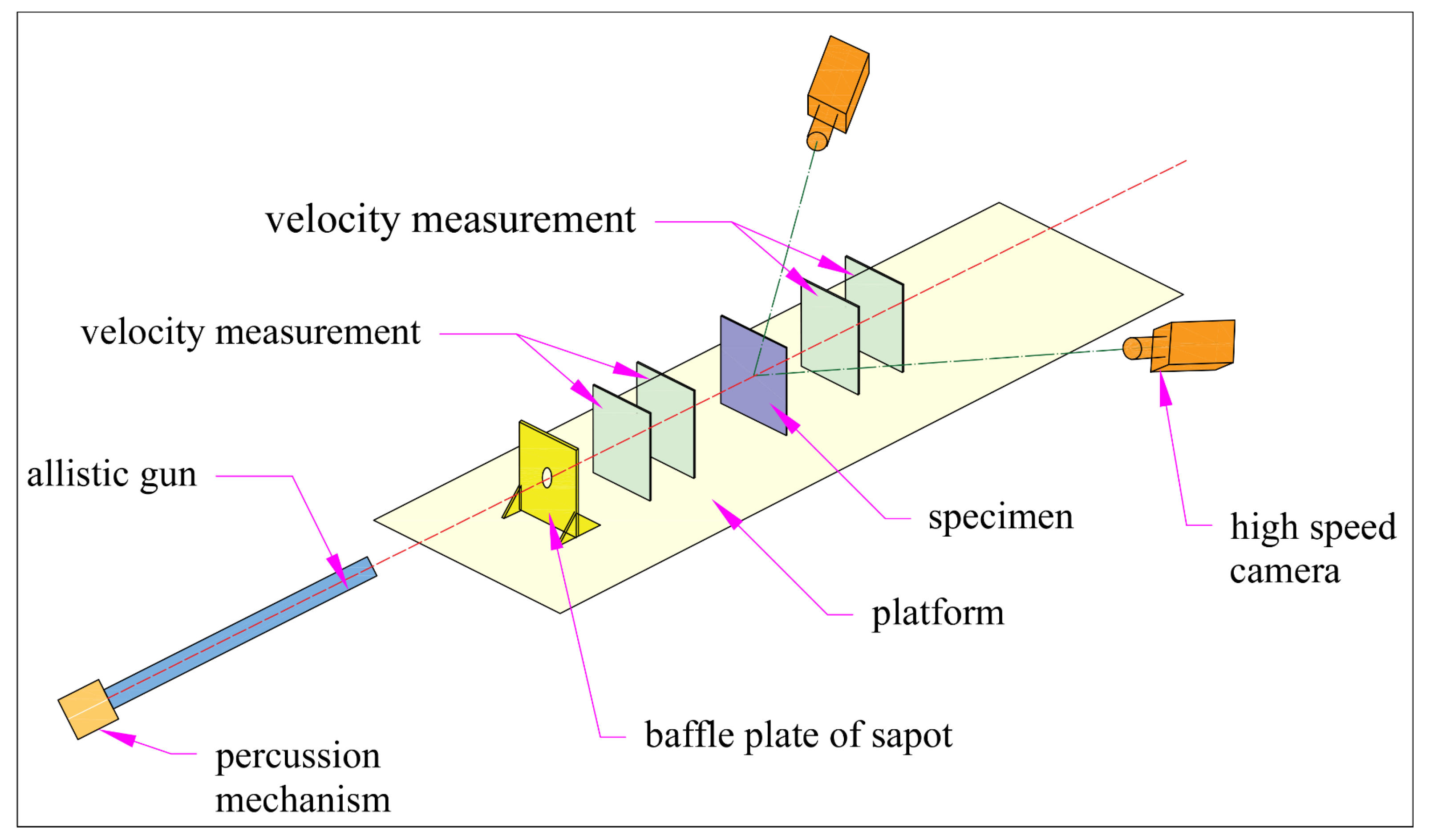
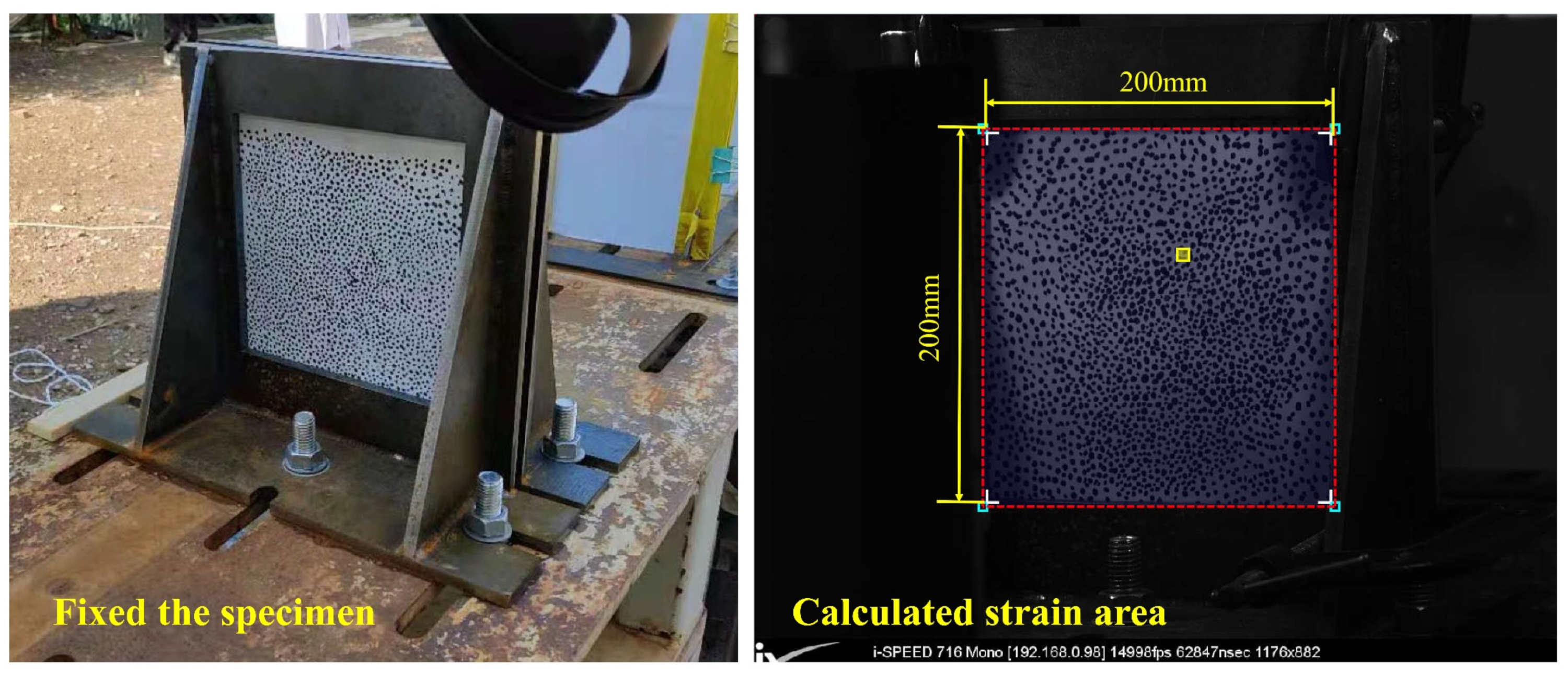



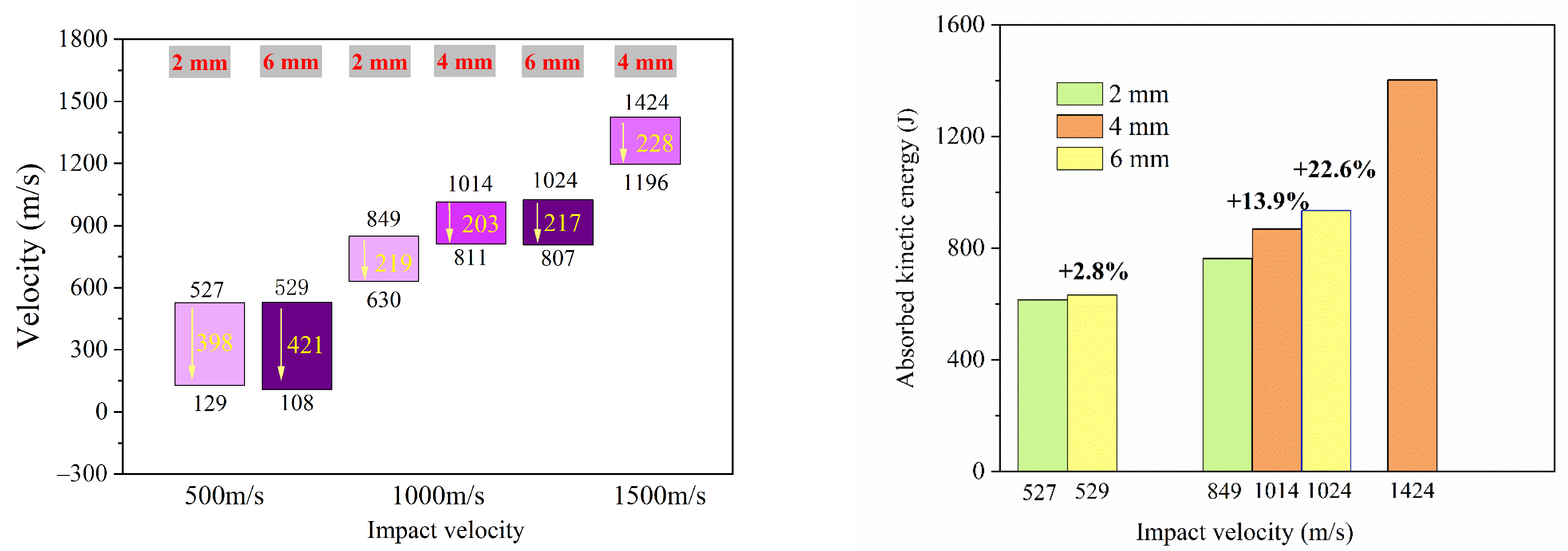
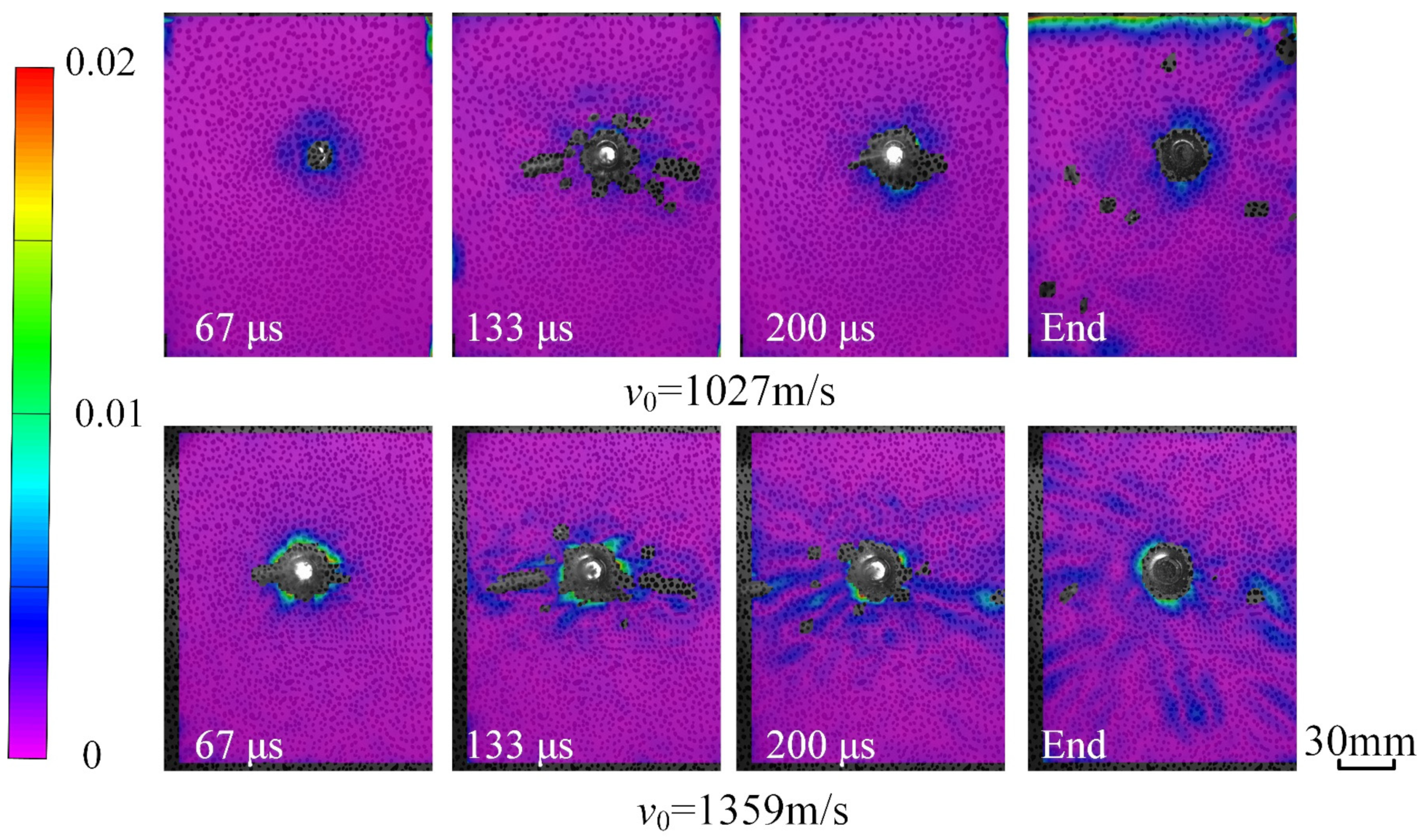
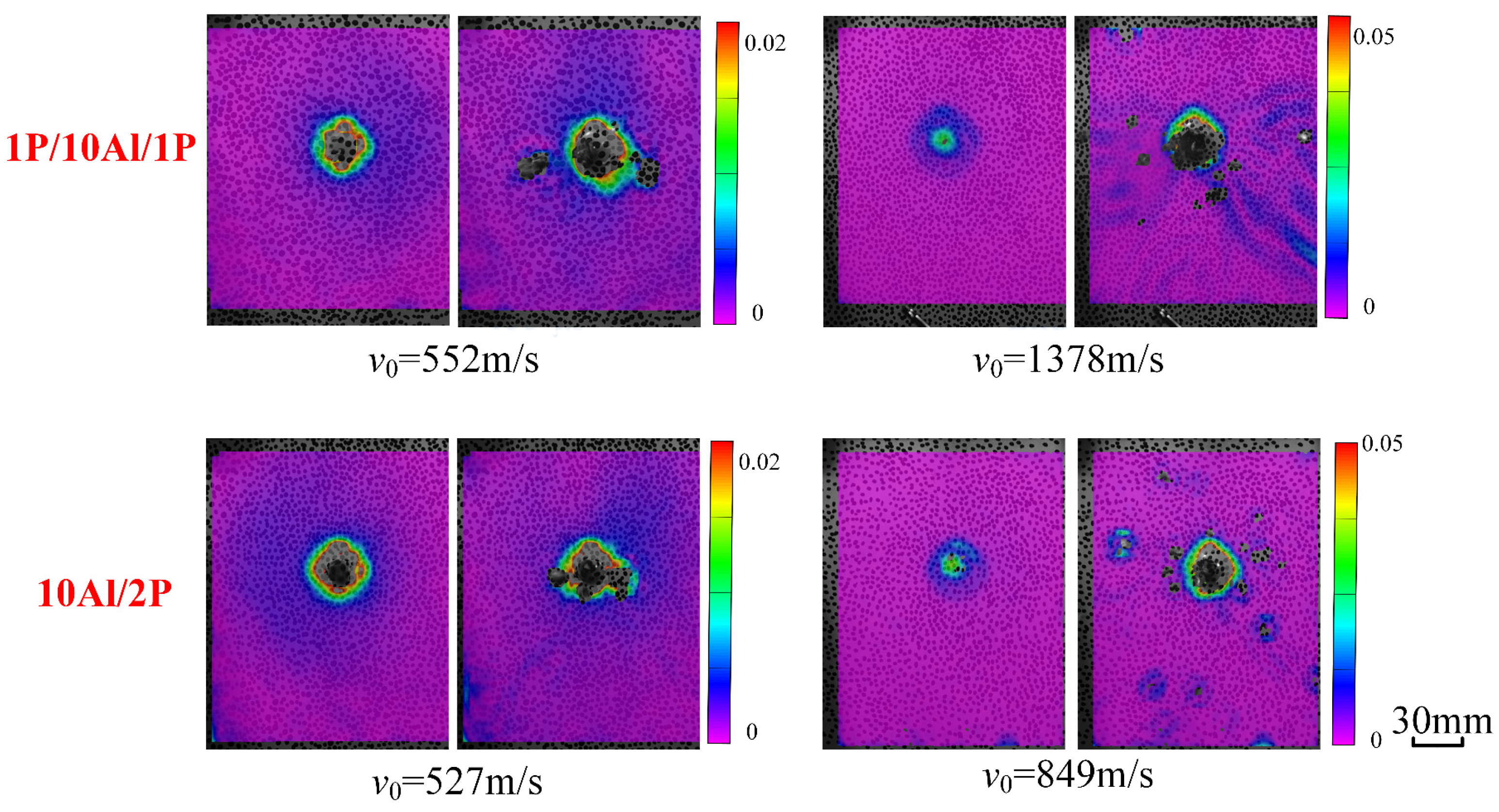
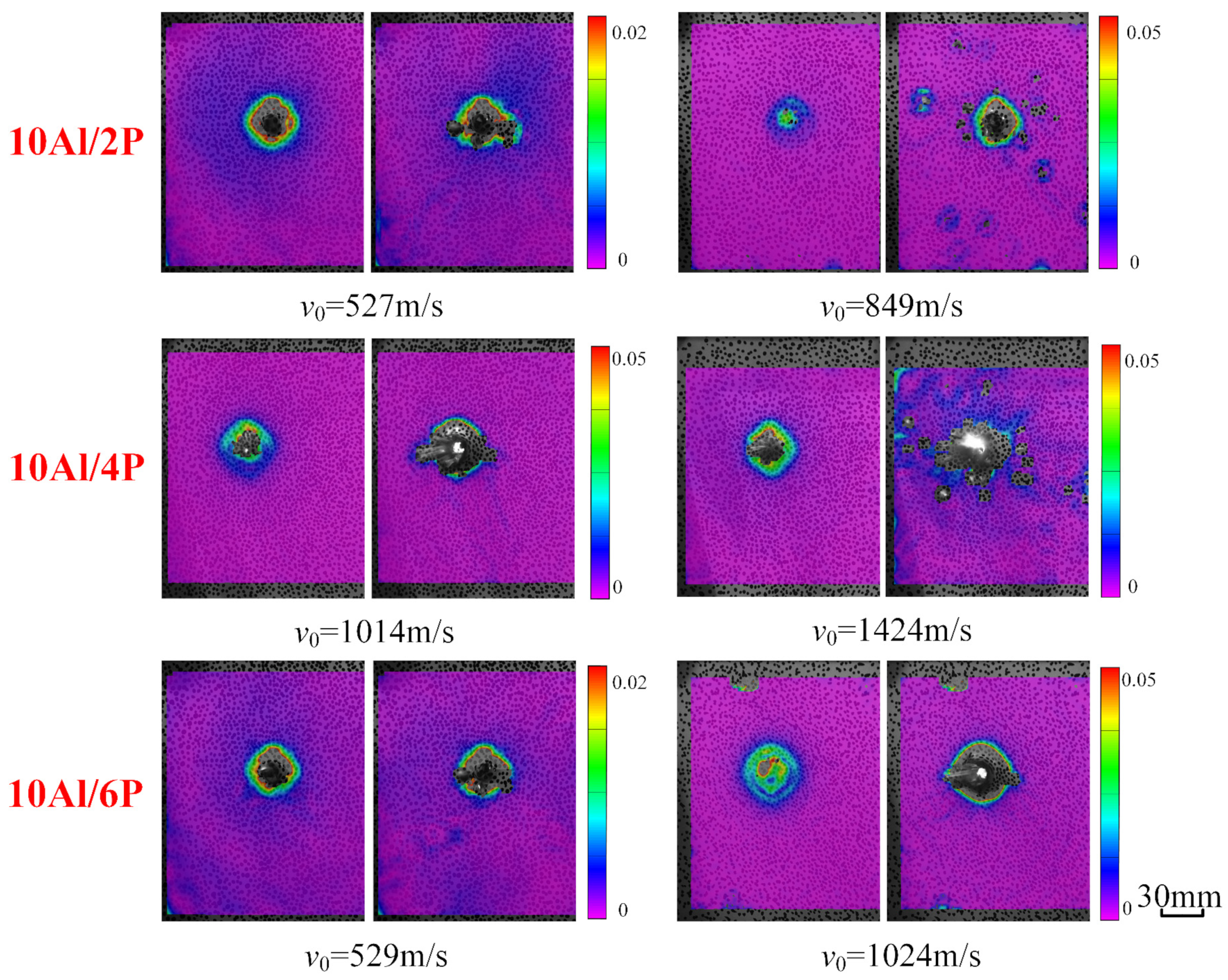
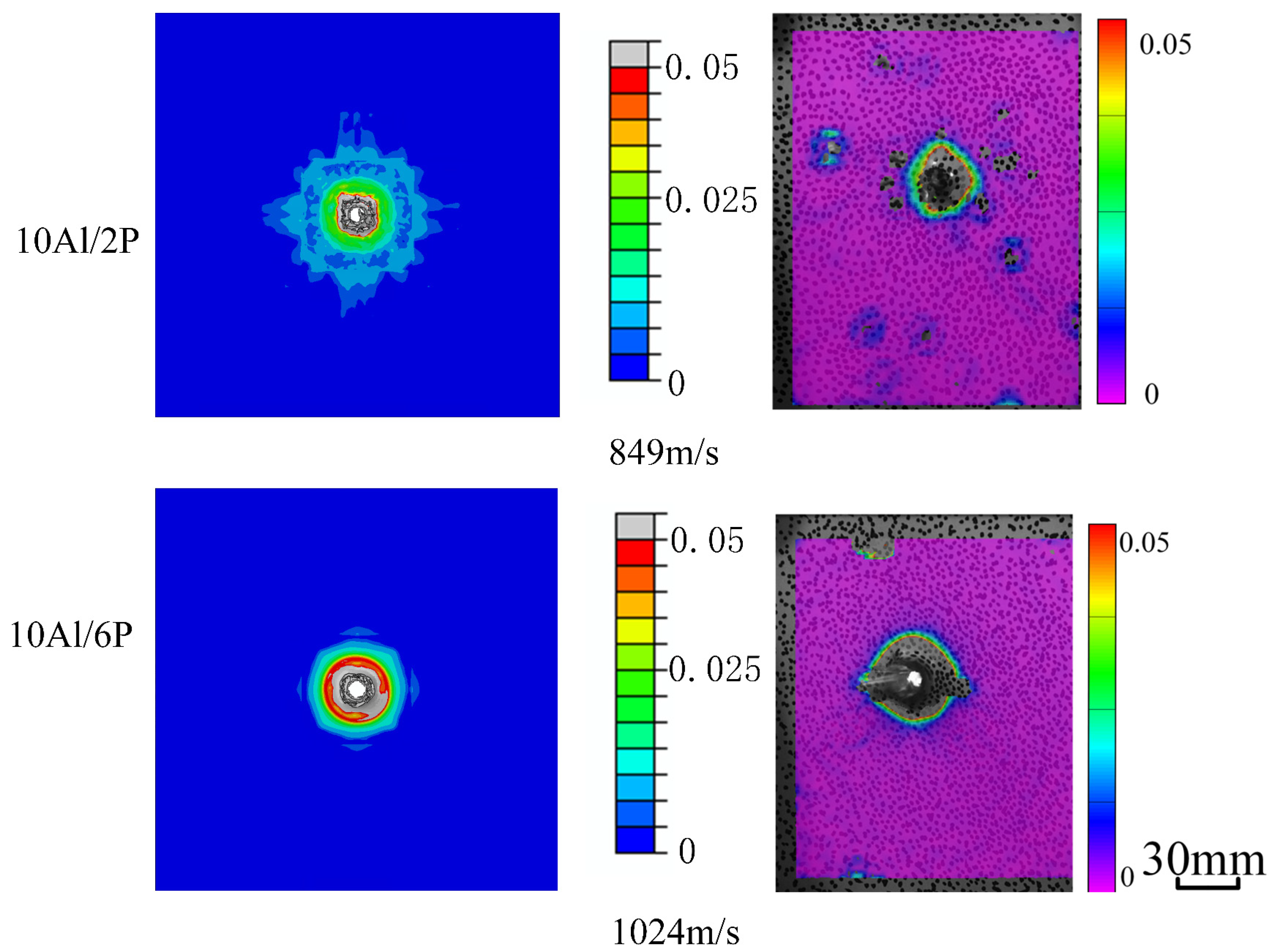


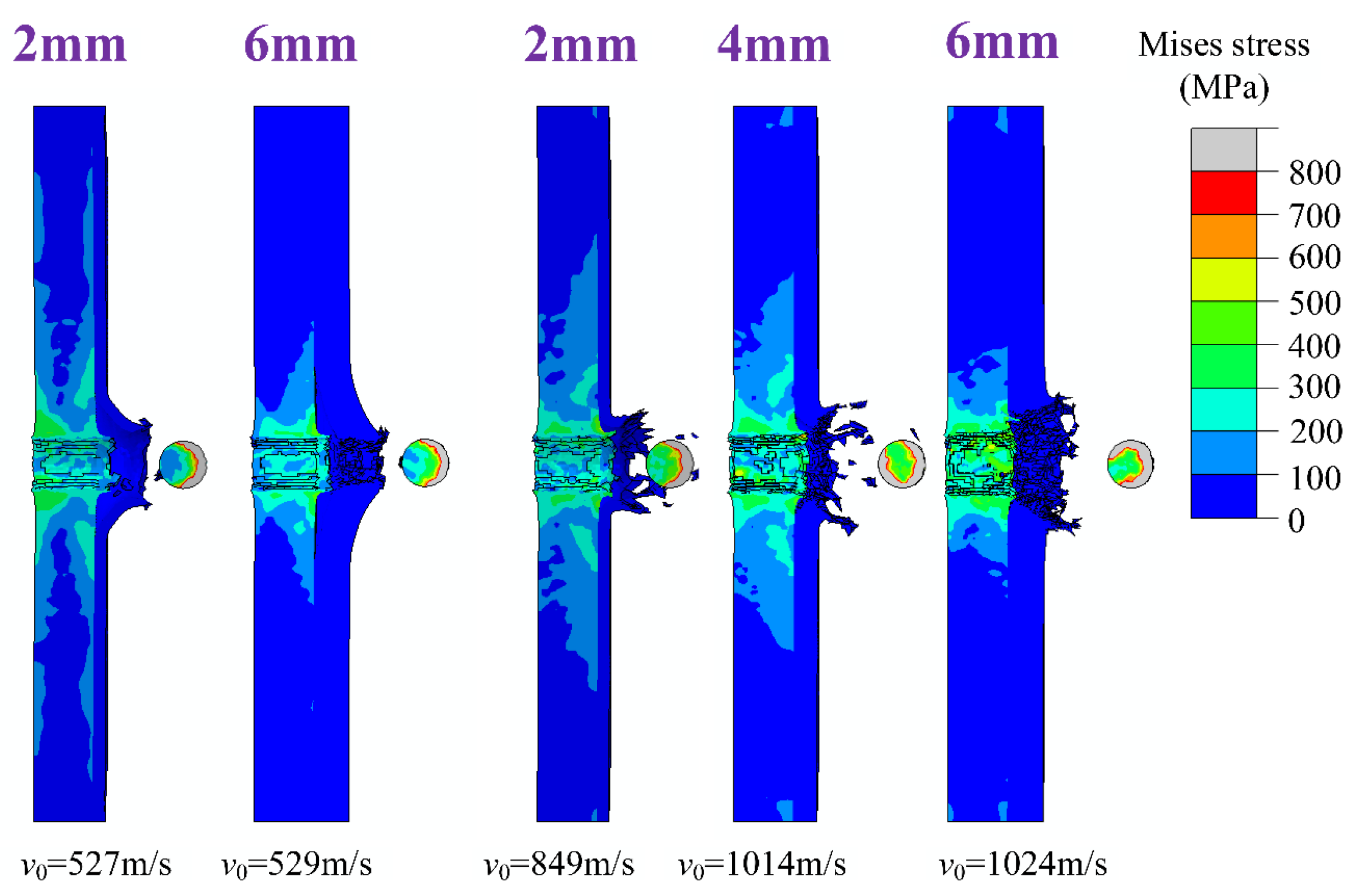


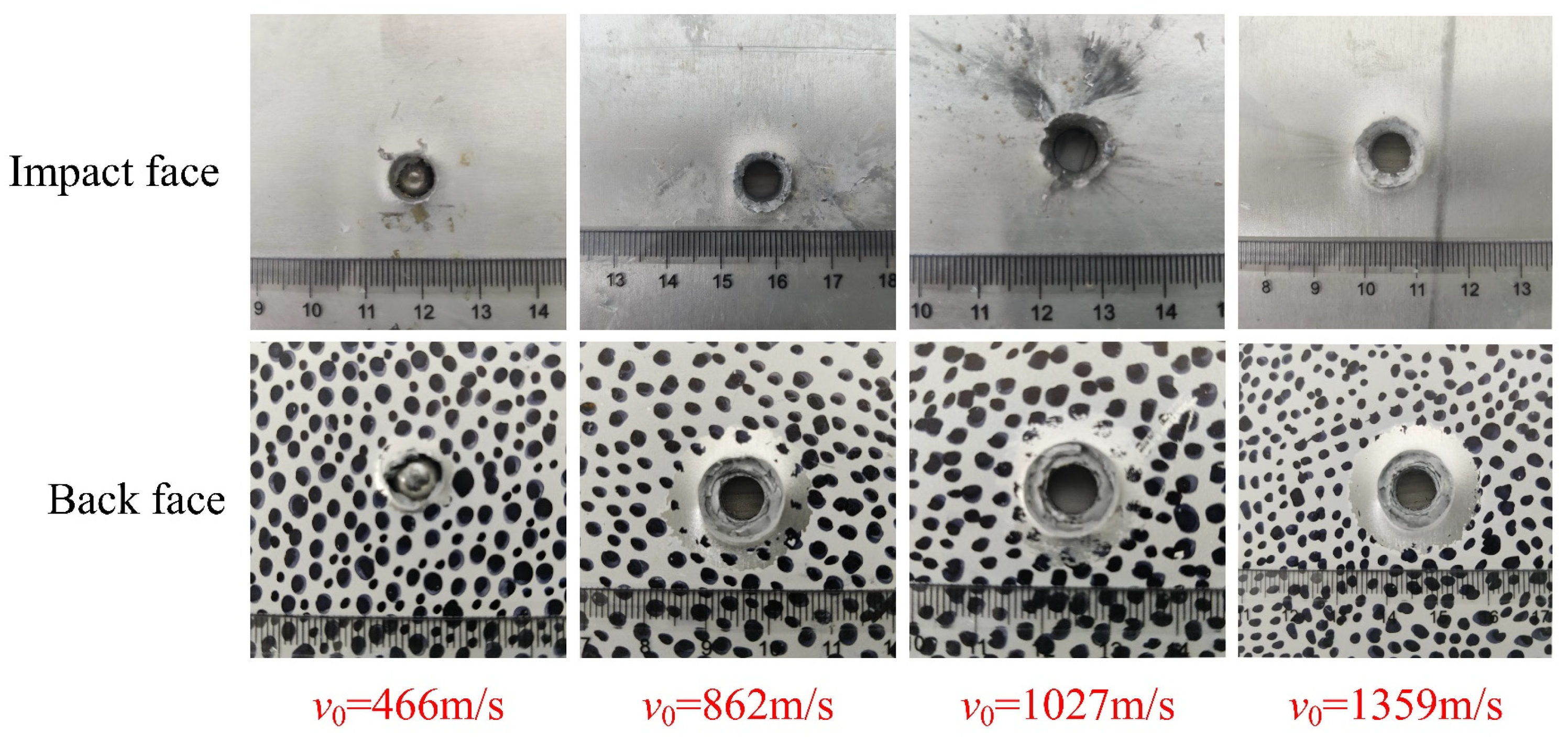
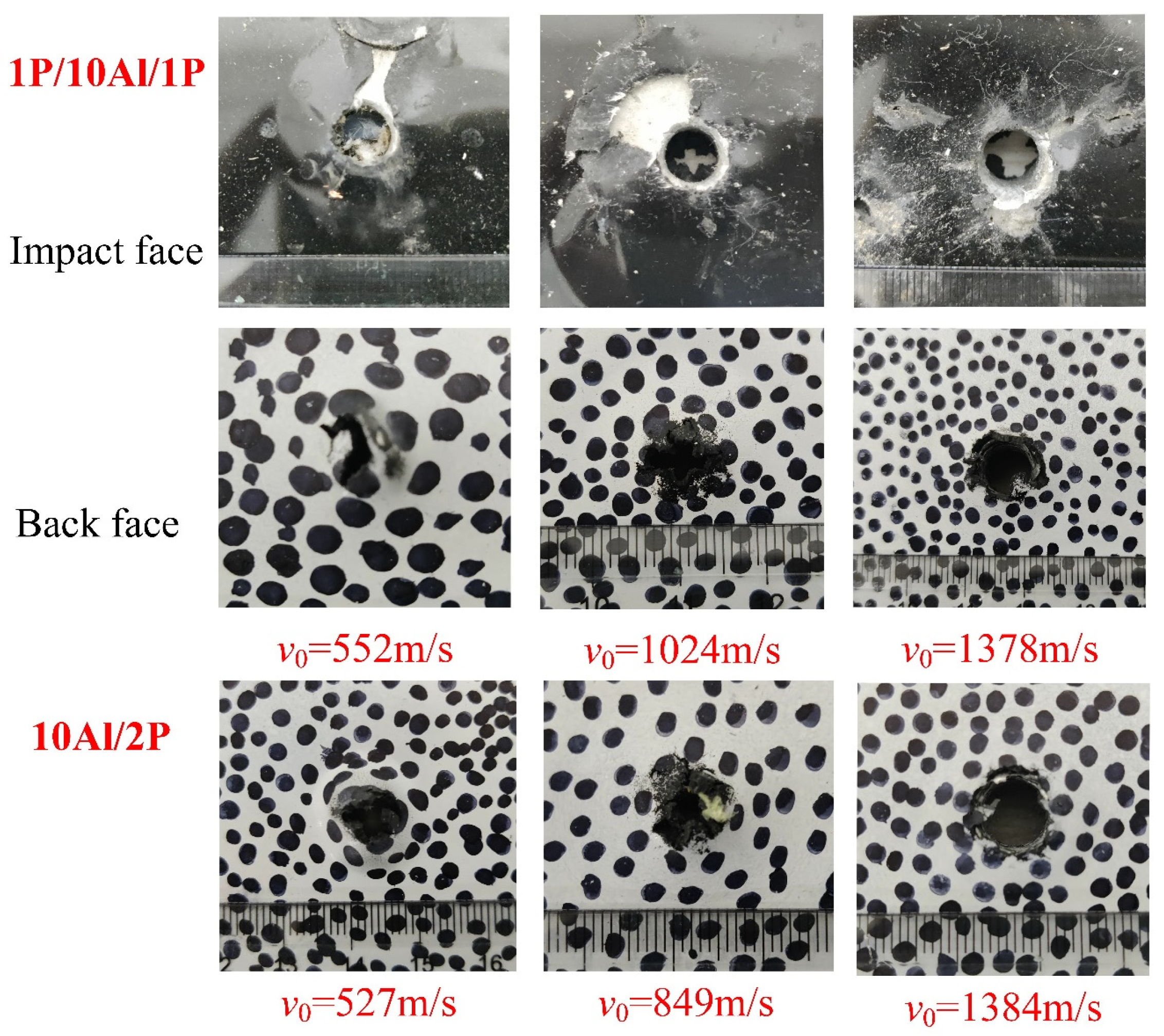

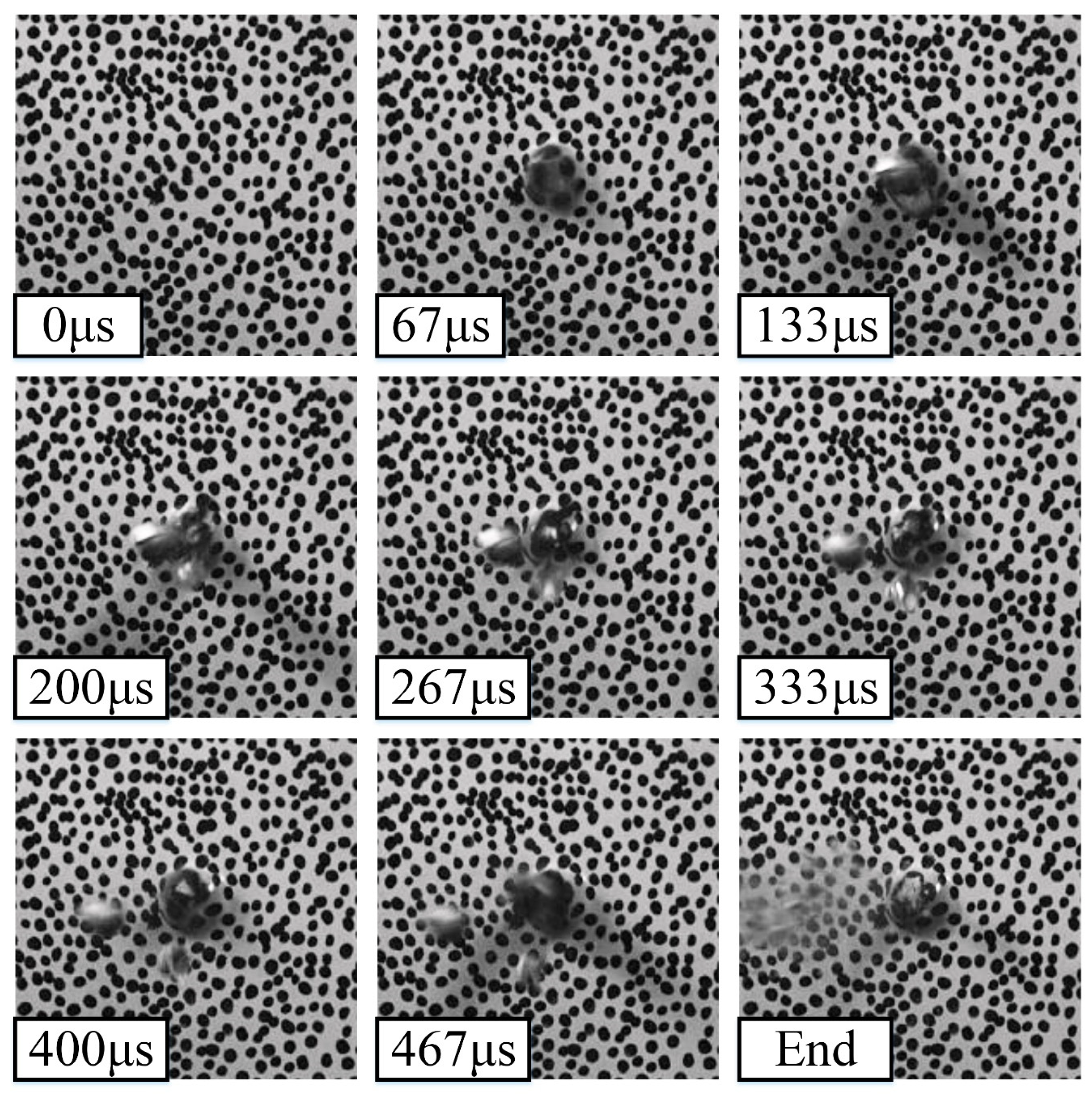
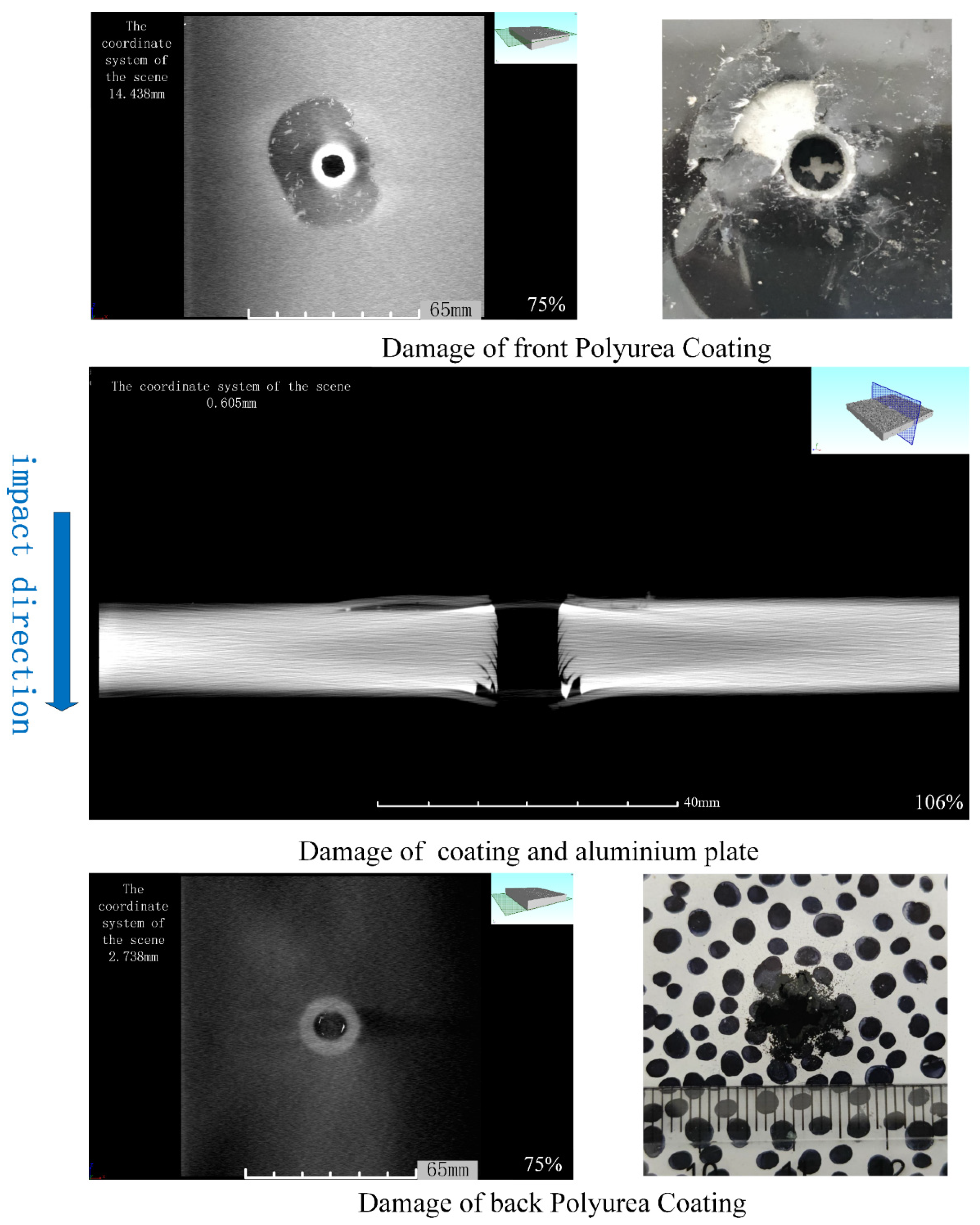
| Group | Configuration | Geometry | Plate Thickness (mm) | Areal Densities (kg/m2) | Impact Velocity (m/s) |
|---|---|---|---|---|---|
| 1 | 10Al |  | 10 | 27.3 | 500/1000/1400 |
| 2 | 1P/10Al/1P |  | 1 + 10 + 1 | 27.5 | 500/1000/1400 |
| 3 | 10Al/2P |  | 10 + 2 | 27.5 | 500/1000/1400 |
| 4 | 10Al/4P |  | 10 + 4 | 27.7 | 500/1000/1400 |
| 5 | 10Al/6P |  | 10 + 6 | 27.9 | 500/1000/1400 |
 | |||||
| Parameters | Unit | Value |
|---|---|---|
| Young’s modulus | MPa | 51.2 |
| Tangent Modulus | MPa | 1.9 |
| Tensile strength | MPa | 18.0 |
| Density | g/cm3 | 1.01 |
| Poisson’s Ratio | 0.4 |
| Parameters | Unit | Value |
|---|---|---|
| Gelation time | s | 10 |
| Tensile strength | MPa | 18 |
| Tear strength | N/mm | 80 |
| Adhesion strength (concrete) | MPa | 3.5 |
| Adhesion strength (steel) | MPa | 11 |
| Hardness | 85–95 | |
| Oil resistance | No rust, no foaming, no shedding | |
| Resistant to liquid media | No rust, no foaming, no shedding |
| Parameters | Unit | 2024 Aluminum | Tungsten | |
|---|---|---|---|---|
| Mechanical properties | ||||
| Density | ρ0 | (g/cm3) | 2.78 | 18 |
| Young’s modulus | E | (GPa) | 73 | 4100 |
| Poisson’s ratio | υ | 0.33 | 0.3 | |
| Johnson-Cook constitutive model | ||||
| Initial yield stress | A | (MPa) | 369 | 1300 |
| Hardening constant | B | (MPa) | 684 | 0 |
| Strain rate constant | C | 0.0083 | 0.06 | |
| Hardening exponent | n | 0.73 | 1 | |
| Thermal softening exponent | m | 1.7 | 0 | |
| Room temperature | Tr | K | 294 | 294 |
| Melting temperature | Tm | K | 772 | 17,900 |
| Reference strain rate/s | 1 | |||
| Johnson-Cook damage model | ||||
| Damage constant | D1 | 0.13 | ||
| Damage constant | D2 | 0.13 | ||
| Damage constant | D3 | −1.5 | ||
| Damage constant | D4 | 0.011 | ||
| Damage constant | D5 | 0 | ||
| Displacement at failure | 0.7 |
| Stress (MPa) | Strain | Strain Rate (1/s) | Stress (MPa) | Strain | Strain Rate (1/s) | Stress (MPa) | Strain | Strain Rate (1/s) |
|---|---|---|---|---|---|---|---|---|
| 0 | 0 | 0 | 0 | 0 | 90 | 0 | 0 | 490 |
| 1 | 0.2 | 0 | 0.5 | 0.1 | 90 | 12 | 0.1 | 490 |
| 5 | 0.1 | 0 | 12 | 0.25 | 90 | 17 | 0.2 | 490 |
| 6.5 | 0.5 | 0 | 15 | 0.5 | 90 | 18 | 0.5 | 490 |
| 8 | 1 | 0 | 18 | 1.0 | 90 | 22 | 1.0 | 490 |
| 18 | 2.7 | 0 | 23 | 1.6 | 90 | 25 | 1.5 | 490 |
| Parameters | Unit | ||
|---|---|---|---|
| Mechanical properties | |||
| Density | ρ0 | (g/cm3) | 1.1 |
| Stiffness matrix in normal direction | Kn | (GPa) | 1.38 |
| Stiffness matrix in first shear direction | Ks | (GPa) | 1.38 |
| Stiffness matrix in second shear direction | Kt | (GPa) | 1.38 |
| Quads damage model | |||
| Nominal stress in the pure normal mode | σn | (MPa) | 80 |
| Nominal stress in the first shear direction | σs | (MPa) | 40 |
| Nominal stress in the second shear direction | σt | (MPa) | 40 |
| Displacement at failure | 0.5 |
Disclaimer/Publisher’s Note: The statements, opinions and data contained in all publications are solely those of the individual author(s) and contributor(s) and not of MDPI and/or the editor(s). MDPI and/or the editor(s) disclaim responsibility for any injury to people or property resulting from any ideas, methods, instructions or products referred to in the content. |
© 2023 by the authors. Licensee MDPI, Basel, Switzerland. This article is an open access article distributed under the terms and conditions of the Creative Commons Attribution (CC BY) license (https://creativecommons.org/licenses/by/4.0/).
Share and Cite
He, C.; Liu, Y.; Yao, Y.; Chen, Q. Experimental and Numerical Investigation of Ballistic Resistance of Polyurea-Coated Aluminum Plates under Projectile Impacts. Crystals 2023, 13, 1039. https://doi.org/10.3390/cryst13071039
He C, Liu Y, Yao Y, Chen Q. Experimental and Numerical Investigation of Ballistic Resistance of Polyurea-Coated Aluminum Plates under Projectile Impacts. Crystals. 2023; 13(7):1039. https://doi.org/10.3390/cryst13071039
Chicago/Turabian StyleHe, Chenglong, Yaqing Liu, Yingkang Yao, and Qihui Chen. 2023. "Experimental and Numerical Investigation of Ballistic Resistance of Polyurea-Coated Aluminum Plates under Projectile Impacts" Crystals 13, no. 7: 1039. https://doi.org/10.3390/cryst13071039
APA StyleHe, C., Liu, Y., Yao, Y., & Chen, Q. (2023). Experimental and Numerical Investigation of Ballistic Resistance of Polyurea-Coated Aluminum Plates under Projectile Impacts. Crystals, 13(7), 1039. https://doi.org/10.3390/cryst13071039






